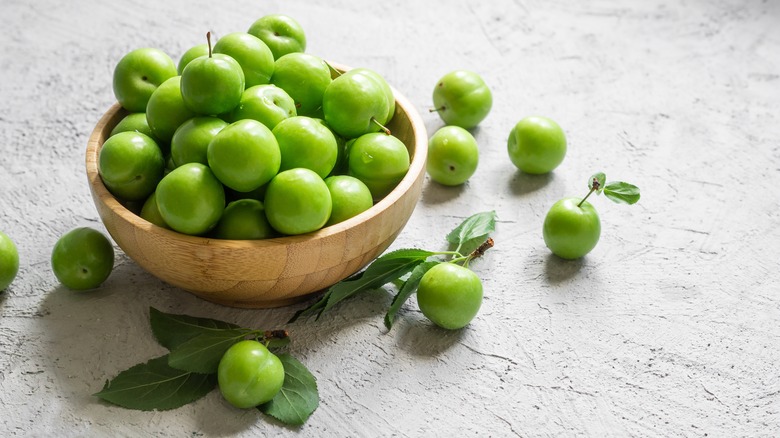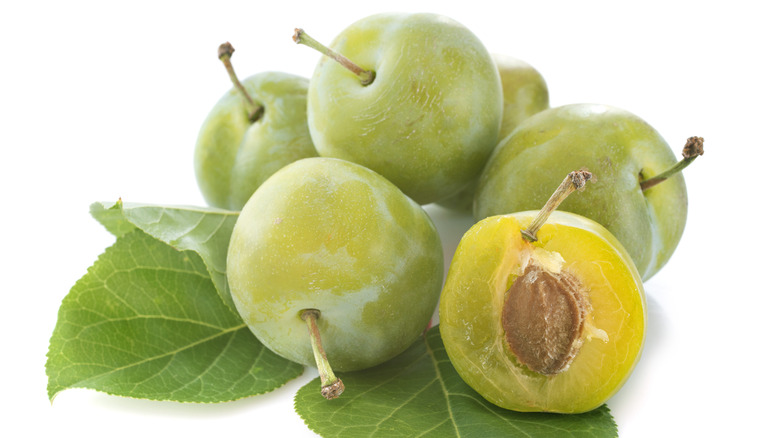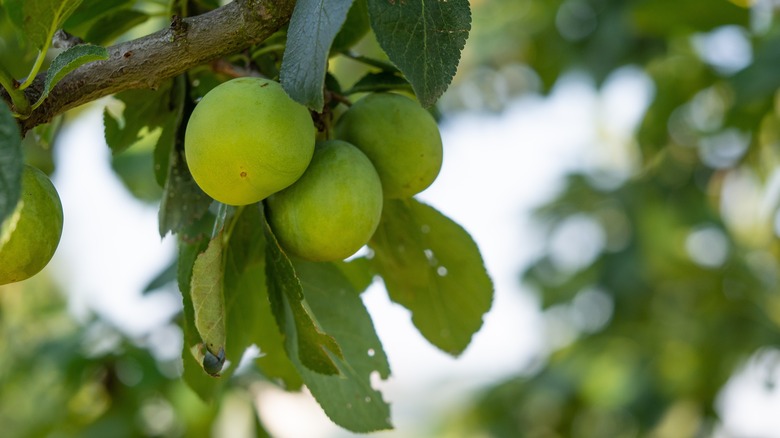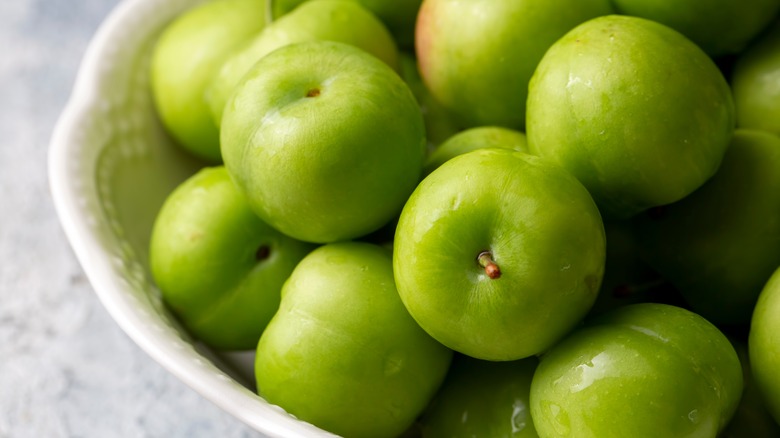What Makes Greengage Plums Unique
If you've never tasted what some consider the most glorious fruit on earth, you're not alone. The elusive greengage plum, once relatively common in America, according to The New York Times, was replaced by sturdier varieties requiring less care and attention. But that makes it even more coveted by in-the-know fruit connoisseurs who eagerly await a fleeting chance to taste the sweet goodness of a greengage harvest.
The wild version of the greengage stone fruit likely originated in Iran but made its way into Western culinary culture in the 1500s by way of France, explains Minnetonka Orchards. King Francis I took the species under his wing, naming it after his wife, Queen Claude. This gave rise to the originally named Reine-Claude Doree cultivar, still reigning in French orchards to this day. After making its way to England, Sir William Gage implemented its cultivation, reportedly leading to the eventual English Green Gauge moniker, as told by Francis Young.
So, what's all the fuss about? Plenty of sweetness and a plum called the "Holy Grail of Stone Fruit" by the Los Angeles Times.
Sweet flavor like no other
From appearance to flavor and growing methods, the greengage stone fruit stands alone in the world of plums. The Los Angeles Times calls it a "modest, subdued beauty" and quotes English food writer Edward Bunyan saying that the greengage has " ... an air of quiet, aristocratic power." That's a lot to live up to, but those who've had the pleasure of tasting the small, round morsels tend to unanimously agree to its magical properties.
Several attributes distinguish greengage from other plum varieties, starting with color. MasterClass notes the green skin and greenish hues of the inner flesh, even when ripe, harboring an unsurpassed juicy sweetness. That sweetness is ultimately what sets it apart from its stone-fruit cousins around the world.
According to the Times, the "fussy and elusive" greengage plums reward fruit indulgers with a pure sweetness level exponentially higher than other plum varieties, measured by the Brix method using a percentage of sugar per 100 grams. Ordinary plums yield juice measuring in the teens or lower, while a single greengage can resister in the upper 30s. Minnetonka Orchards equates this to the water in a greengage plum bearing 40% sugar. Specialty Produce describes the flavor sweet as honey and syrupy with nuances similar to mango, apricots, and citrus marmalade.
Elusive greengauge beauties
Greengage fruit is hard to come by in the United States. This is partially due to its finicky nature and a need for more "chill hours" than other fruits. This refers to the growing hours in which the fruit must stay in the 32 to 48 degrees F range, explains writer and fruit scholar David Karp to the Los Angeles Times. The ripe fruits are also too delicate for shipping across the country, cutting down on their economic viability for growers.
Experiencing a true, fresh greengage may require a classic road trip to California. Andy Mariani runs the three-acre Andy's Orchard in Morgan Hill, California, which is considered the largest commercial producer of greengage plums in America, according to Karp. Competition is sparse, likely coming from just three other orchards nationwide. Harvest happens quickly at Andy's, with fruits selling quickly at farmers markets and demand outpacing supply in some years — because the trees bear heavy yields in one year and sparse offerings the following year, known in the fruit industry as "alternate bearing."
Growing and eating greengauge plums
Though finding greengage plums picked and ready-to-eat from commercial growers can be a bit tricky, Minnetonka Orchards gives advice on how to grow them yourself. Sellers such as Willis Orchards and Orange Pippin offer saplings for sale online, but home growers are in it for the long run. After planting in chalky soil in hardiness zones 4 to 8, it typically takes at least seven years for young trees to bear fruit. Greengage plums need a hot location with full sun, cool nights, consistent pruning, and a dry harvest season since rain can lead to cracking and rotting of ripened plums. They also need cross-pollination from other European-lineage plum trees. A pollination checker from Orange Pippin recommends dozens of options for pollinating Old Green Gage plum trees.
The time from ripeness to picking can be as little as seven days, typically from August to September. Once you have those prized sweet possessions in hand, just eat them fresh unless you happen to have an extraordinarily high yield. Try pairing them with wine and cheese, per Minnetonka Orchard, and never dilute the coveted sweet flavor with added sugar. If truly necessary due to a miraculous overabundance, make a simple sorbet to let the flavor shine, or bake them into a plum cake and freeze them for a special treat while awaiting the following year's harvest.



